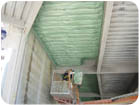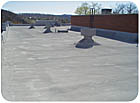
As building owners and developers demand higher performance buildings, architects, specifiers and designers look for building materials that make a greater contribution to sustainability, durability, energy efficiency and improved occupant comfort and safety. At the same time, these materials must have a low environmental impact and if possible, the flexibility to promote design freedom.
Most people don't automatically think about chemistry when they think about sustainable construction and design freedom. Yet the versatility of polyurethane chemistry helps spray polyurethane foam make significant contributions to high performance buildings.

The chemistry
One material that is starting to receive attention for these important traits is SPF. The material is a two-component product that is manufactured on-site but engineered in the molecular level to optimize performance for a specific application. Each batch is tailored to meet the demands of that specific job. The isocyanate ("A" component) is a designed molecule-not a distilled byproduct-that allows the chemist to manipulate it for an intended use. The isocyanate used for the manufacture of polyurethane coatings is designed to be different from that used for rigid insulation boards. The isocyanate used for board stock is designed to be different from that used for SPF. Their differences are engineered into the base molecule to yield a finished product designed specifically for optimum performance in its intended use.The resin ("B" component) is a combination of a dozen or so compounds. A single isocyanate can be matched with literally hundreds of different resins to create an SPF product engineered for the specific performance task. By varying key components within the resin, the finished product can be modified for roofing applications, insulating air barrier systems, adhesive applications or wall insulation for both residential and industrial/commercial markets.
Types and Properties
Three types of SPF are commonly used within the construction industry and offer different properties:-
Medium-density
- Structural strength
- High moisture resistance
- High insulation values
-
Low-density
- Lower insulating value and moisture resistance
- Sound control
-
Sealant foams
- Continuity
- Gap and crack filling
Another consideration is whether the formulation is a closed-cell or open-cell foam. Medium-density SPF has a closed-cell content of greater than 90 percent and meets ASTM 1029/SPFA guidelines. Closed-cell formulations typically range in density from 27 to 51 kg/m3(1.5 to 3 pcf), while compressive strength ranges from 103 to 345 kPa (15 to 50 psi). The density and composition of closed-cell foams can add structural integrity to the building.
Open-cell foams used for insulation have approximately 60 percent open-cell content and offer densities of 8 to 16 kg/m3(0.5 to 1 pcf) and compressive strengths of 28 to 83 kPa (4 to 12 psi), adding minimal or no structural integrity. These products are performance upgrades from glass fiber materials as they deliver comparable R-value and some degree of air barrier performance.
R-values of closed-cell SPF used in air barrier, insulation and roofing applications with densities ranging from 24 to 51 kg/m3(1.5 to 3.0 pcf) typically range between 6.0 and 7.5 per inch. Low-density 8 kg/m3(0.5 pcf), open-celled SPF typically has a stable aged R-value ranging from 3.4 to 3.6 per inch.
Both types are fully adhered and monolithic but open-cell foams have far greater air and vapor transmission capabilities. As such, these products do not qualify as air barriers as defined in ASTM International E 2178, "Standard Test Method for Air Permeance of Building Materials."
The choice between open-cell and closed-cell foams is usually made based on economics vs. thermal efficiency. Open-cell foams tend to provide a better yield than closed-cell foams and installed costs are approximately 60 percent of those of closed-cell products. However, closed-cell foams offer far greater performance attributes that make important contributions to the lifecycle cost and sustainability of the building.

Contributions to high performance buildings
An estimated 54 percent of energy consumption in the United States is directly/indirectly related to buildings and their construction.1 The U.S. Dept. of Energy reports 40 percent of the energy cost of heating and cooling a building is wasted by uncontrolled air leakage through the building envelope.Although "green building" standards, such as Building for Environmental and Economic Sustainability and Leadership in Energy and Environmental Design, do not specifically mandate or reward the use of air barrier systems in new construction (the term "air barrier" does not appear in the LEED-NC V2.1 Rating System document; however some feel that EA Prerequisite 2, EA Credit 1 and ID Credit 1 should involve the use of air barrier systems), Massachusetts' mandates the use of air barriers in its Commercial Energy Code and approximately 29 other states include air barriers in their provisional codes.
A report issued in June, by the National Institute of Standards and Technology, evaluated the energy savings of an effective air barrier requirement for non-residential buildings in five American cities using the scalar ratio methodology employed by ASHRAE SSPC 90.1:
"Despite common assumptions that envelope air leakage is not significant in office and other commercial buildings, measurements have shown that these buildings are subject to larger infiltration rates than commonly believed. Infiltration in commercial buildings can have many negative consequences, including reduced thermal comfort, interference with the proper operation of mechanical ventilation systems, degraded indoor air quality, moisture damage of building envelope components and increased energy consumption."2
The NIST study shows that the inclusion of an air barrier system in non-residential buildings can reduce air leakage by up to 83 percent to achieve a large reduction in energy consumption and operating costs with potential gas savings of greater than 40 percent and electrical savings of greater than 25 percent.3
Canadian architects and builders have successfully used closed-cell SPF insulating air barriers for 15 years on industrial, commercial and institutional buildings, both low- and high-rise. SPF air barrier systems use the versatility of polyurethane chemistry to combine superior insulation R value with seamless, almost-zero air permeability for increased building energy efficiency, durability and occupant comfort, health and safety.
The Air Barrier Association of America approves the use of closed-cell SPF insulating air barrier systems to meet the 29 state commercial energy codes that meet or exceed ASHRAE 90.1-89, Energy Standard for Buildings Except Low-Rise Residential Buildings and ASTM International E 2178, Standard Test Method for Air Permeance of Building Materials.
SPF roofing also contributes to building energy efficiency. Texas A&M University studied the energy efficiency performance of 27 different buildings on the campus that had received an SPF roof between 1980 and 1984. The results show the university was able to recover the complete cost of the roofs through energy savings realized over an average of four-and-a-half years.4
Durability
Closed-cell SPF formulations can actually improve building durability. Testing results, conducted by the National Research Council of Canada's Canadian Construction Materials Centre, show SPF air barriers offer long-term durability greater than or equal to the building's life span. Testing conducted by the National Association of Home Builders Research Center shows SPF insulation between wood- and steel-stud wall panels increased rack and shear two to three times over standard stick-built components and glass fiber insulation when sprayed onto gypsum wallboard and vinyl siding, and increased racking strength by 50 percent when sprayed onto oriented strandboard.5In the mid 1990s, NRCA's National Roofing Foundation commissioned Structural Research Inc. to perform an independent field and laboratory assessment of SPF roof systems to establish and verify existing performance attributes.6
The NRCA/NRF study, combined with testing performed by Underwriters Laboratories Inc. and FM Global, along with documentation gathered by Thomas L. Smith of TLSmith Consulting after Hurricane Andrew, shows the following about SPF's performance:
Compressive strength
The average compressive strength for all samples was 404 kPa (58.6 psi), while the highest compressive strength of 685 kPa (99.3 psi) was recorded at a New York installation with silicone coating, dating 1975. (Minimum required compressive strength for newly-installed SPF roofs is 276 kPa [40 psi].)7(Determined using ASTM D 1621, Standard Test Method for Compressive Properties of Rigid Cellular Plastics.)
Apparent core density
The average apparent core density was 51.6 kg/m3(3.2 pcf) for all samples. The highest was 78 kg/m3(4.9 pcf) from a location in Wisconsin installed in 1974, while the lowest was 30.1 kg/m3 (1.9 pcf). The author of the report, Rene M. Dupuis, of Structural Research Inc., noted the recommended minimum foam densities for newly installed SPF roofs had risen over the years to a minimum 44.9 kg/m3(2.8 pcf) by the 1990s. (Determined using ASTM D 1622, Standard Test Method for Apparent Density of Rigid Cellular Plastics.)
The newest SPF roof in the NRCA/NRF study had a core density of 64.1 kg/m3 (4.0 pcf) with a compressive strength of 448 kPa (65 psi). The oldest (installed in 1975, at the time of the study this roof was about 21 years old) had a density of 56.4 kg/m3 (3.5 pcf) with a compressive strength of 685 kPa (99.3 psi).
Moisture content values
Average moisture content was negligible, at 1.02 percent by weight. Dupuis noted the physical properties of the evaluated roofs came up positive-regardless of the age of the installation-in most cases exceeding the required minimums for new installations despite in-field service of 25 years or more. (Determined by oven drying samples at 50 C [122 F].)
Environmental responsibility
SPF systems feature zero ozone-depleting blowing agent technology. Open-cell formulations usually use water as their blowing agent, producing CO2 gas, which is replaced by air within a few days. Closed-cell formulations use zero-ozone depleting materials, such as HFC-245fa or proprietary, like Honeywell's Enovate, all of which are approved under the Environmental Protection Agency's Significant New Alternatives Program. As well, SPF emits no volatile organic compounds during installation or during occupancy.8The author's company's Eco-Efficiency Analysis assesses total cost and ecological impact over the product lifecycle to benchmark current performance and get insight for future improvements. The SPF systems evaluated outperformed traditional insulation materials in eco-efficiency on their test scores.
When combined with appropriate coatings, SPF roofing systems are Energy Star compliant, working to reduce urban heat island effect and reducing HVAC loads. In addition, SPF roofing systems apply to the existing substrate without tear-off in 95 percent of retrofit situations, greatly reducing the amount of construction debris consigned to landfills. A typical 10,000-square-foot roofing project produces less than a one-half cubic yard of scrap, tape and plastic, and from one pint to three gallons of waste solvent. Some manufacturers' SPF contains up to 10 to 20 percent post-industrial and/or post-consumer recycled content.
SPF roofing systems offer a lifespan of 20 to 30 years and can be renewed indefinitely with simple recoats. The SPF systems are manufactured on-site, reducing the environmental impact resulting from transportation of materials.
Looking Forward
Despite preconceived notions, chemistry can improve overall building performance and aid in sustainable construction and design. The versatility of polyurethane chemistry helps SPF make significant contributions to high performance buildings.Knowing the types and properties of various formulations, along with their specific contributions and best applications, can help one make the right decision when it comes to considering and selecting foam for a project.
If you read this article, please circle number 335.

Report Abusive Comment